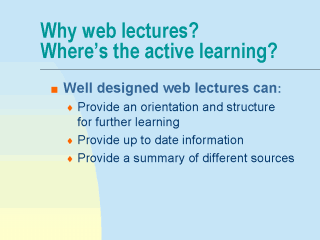 |
As a delivery
tool, the lecture has received criticism lately as falling short of actively involving the
learner. In typical lectures, students begin losing attention after the first ten minutes.
The information flows from the instructor to the students, with students frequently
writing verbatim what was just heard from the instructor or displayed on the chalkboard.
Consequently, lectures have been criticized for proliferating lower level cognitive tasks
that entail memorizing information. How, you might ask, does preparing a lecture for the
web involve any differences in attention and learning? The goals of an in-class lecture
may be very different from a web lecture. A web lecture can be viewed as an extraction of
a class lecture. It can provide an overview of the structure of an upcoming class,
prefacing the face-to-face presentation. An instructor can easily ask students to review a
web lecture and construct one question that warrants classroom discussion. Or, the lecture
can be assigned as a prologue to a class followed by a pre-test on class material, giving
the instructor diagnostic information about areas that need clarified or explained
further. Because web lectures are easily scanned for key points, they can give students a
glimpse of topics that they may want to research further. Web lectures can also provide
current information in an abbreviated form prior to journal publication. |
